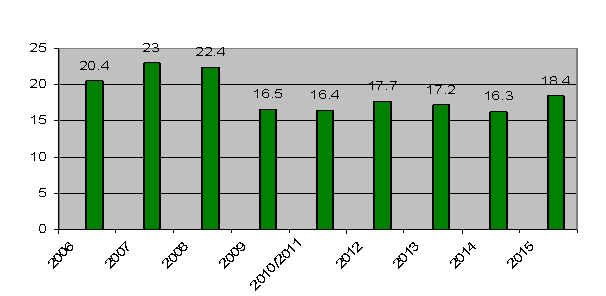The New Zealand National Average Turnover
The National Staff Turnover Survey by Lawson Williams has once again produced some very interesting findings that will assist participating companies to better understand effective recruitment processes.
The national average turnover for 2015 was 18.4%. This is the highest rate since 2008 showing an 11.4% increase on 2014.
Factors such as an aging workforce, skill-shortages, attitudinal shifts to the desirable speed of changing jobs, reduced loyalty, rapid organisational change producing redundancy & reduced job security have all driven gradual increases in turnover during most of the past twenty years.
These increases came to an abrupt halt after the onset of the Global Financial Crisis in 2007 and subsequent recession of 2008 & 2009. Turnover decreased by well over a quarter (28.3%) since its peak of 23.0% in 2007.
Furthermore the 2008 figure of 22.4% masked a significant jump in involuntary turnover, with 4.5% of the total (about one-fifth of departures) being involuntary and with that increase almost certainly being due to a sharp increase in redundancies in the second half of the 2008 calendar year. 2009 saw a dramatic drop in voluntary turnover from 17.5% in 2008 to 12.8%. More than one departure in five was involuntary, again suggesting a high rate of redundancies that year.
Since 2009 with the end of the recession and the move to a more stable but very low growth economy, the labour market has stabilised and shown some very gradual improvement. This was reflected in voluntary turnover increasing from 12.8% to 13.4% and involuntary turnover reducing from 4.6% to 4.0% for the year ending 31 May 2011. In turn, the very gradual improvement continued with voluntary turnover increasing slightly from 13.4% to 13.7% in 2012 and involuntary turnover reduced from 4.0% to 3.8%.
In 2013 we noted a reversal in both voluntary and involuntary turnover. Voluntary decreased slightly to 13.3% from 13.7% which was indicative of the continuing uncertainty in the employment market in most sectors through to late 2013. Involuntary increased slightly from 3.8 to 4.1 which again may indicate that some companies were still in restructure or reduction mode in 2013. The average turnover rate in 2014 remained relatively stable with a small decrease from 17.2% in 2013 to 16.3% in 2014.
This slight decrease reflected that even though the economy was showing positive signs of growth this was not reflected in employment activity across all sectors and an increase in voluntary turnover. We noted that throughout 2014 and particularly in the 4th quarter a record number of people entered the workforce and the participation rate reached an all time high, yet wage inflation was mild. This left the economy in a strong position of economic growth with little inflation which led to the speculation that low wage inflation i.e. a lag in salary increase behind economic growth might impact on peoples desire to voluntarily seek new employment in 2014.
In 2015 we have seen a significant increase of 11.4% in the national average turnover to the highest level of 18.4% since 2008. Low wage inflation continued throughout 2015 easing to 1.5% annually, the lowest since the March 2010 quarter, however this appears to have had little impact on peoples desire to voluntarily seek new employment in 2015. This increase in turnover reflects the generally positive economic performance in 2015.
The national unemployment rate rose throughout the year to 6.0% then fell rapidly to 5.3% in the 3 months to December. This was well below the market expectation of 6.1%.This is the lowest rate since March 2009 as the number of unemployed went down by 10.9% while employment increased by 0.9%. The overall annual employment growth reached 1.3%. Statistics NZ noted that employment had been strong especially for the 20 – 29 year group with 26800 more people employed in the age group over the year. There were also just over 23000 more people employed in Auckland over the year. The largest rise in employment was in the construction industry. Manufacturing growth for the first time since December 2010 overtook construction through the middle of 2015. The top regions for employment growth in manufacturing were Auckland and Canterbury.
Involuntary turnover has shown an increase in 2015 to 3.9% from 3.5% in 2014. On the surface this may be somewhat surprising given the relative positive economy of 2015. Prior to 2014 an increase in Involuntary turnover was always met by a decrease in voluntary turnover however in the last two years they have followed each other with a decrease in both in 2014 and a subsequent increase in both in 2015. Voluntary turnover has increased in 2015 to 14.2% from 12.6% in 2014, an 11.3% increase.
Since 2014 these figures indicate an economy of significant variability. Growth and confidence in Auckland and Canterbury and in sectors such as construction is not reflected across all regions and sectors in 2015. Some
organisations are still in a mode of restructuring and increasing their levels of Involuntary turnover resulting in a national increase at the same time as a national increase in Voluntary turnover.
As we present these 2015 survey results in early 2016, amidst a range of mixed market conditions we will be interested to note if the variability of turnover rate continues to reflect this. We will look with interest to the 2016 results to see if the strong correlation between staff turnover and economic performance continues.

